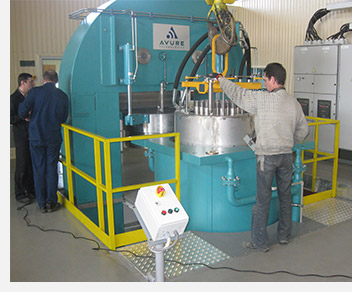Hot Isostatic Pressing (HIP) Cycles
One or more prepared cans of material and/or castings are loaded into the tooling/work space of the hot isostatic pressing unit. The number and arrangement of the components is limited only by the necessity to ensure that the desired temperature be maintained uniformly and that adequate mechanical support is provided. Conventional alumina kiln furniture is used for some parts. Ceramic crucibles and/or boats can handle small parts.
Various grades of alumina powders and balls can also provide the required mechanical support. It is common practice to bench pack a large mild steel cylinder, which is sized to fill the work space of the system, with as many parts as feasible so that only a single element need be inserted and removed from the chamber. In small laboratory-size equipment, loading is done directly into the HIP unit, but the method described previously is used in larger systems.
 The hot isostatic pressing unit is closed and locked, evacuated to minimize contamination of the pressurizing gas, and then the pressure and temperature are usually raised simultaneously. When glass or other brittle canning materials are used, minimum temperature levels are established first to ensure that the canning material is adequately ductile before pressure is applied. In other cases, the load is pressurized cold to an intermediate level then the pressure is raised to the designed working level by increasing the temperature.
The hot isostatic pressing unit is closed and locked, evacuated to minimize contamination of the pressurizing gas, and then the pressure and temperature are usually raised simultaneously. When glass or other brittle canning materials are used, minimum temperature levels are established first to ensure that the canning material is adequately ductile before pressure is applied. In other cases, the load is pressurized cold to an intermediate level then the pressure is raised to the designed working level by increasing the temperature.
After reaching the desired pressure and temperature levels, the system is kept at a "hold" or "soak" condition to ensure that the center of the load has reached the set conditions. No generalizations can be made covering the time required since that is a function of the load characteristics, shape, mass, part composition, configuration of loading. Thermocouples placed in the load indicate completion of the minimum soak time. Additional time may be specified to achieve particular metallurgical properties. These are separately evaluated on the basis of diffusion rates and similar factors in a given application.
Finally, pressure and temperature are allowed to drop. Normally the furnace is merely shut off completely, and the temperature is allowed to decrease at its maximum rate. Pressure is usually allowed to drop in thermodynamic ratio to the temperature drop since bleeding off gas to reduce the pressure will slow down the cooling rate. Some materials require slower, controlled cooling which can be achieved in most hot isostatic pressing systems. Once the cool-down phase is complete the system is ready for venting to zero pressure and unloading. This is a normal production cycle condition. There are some operations that can achieve two to three cycle runs per day, while others, governed by the nature of the cycle required by the product, might run up to seven or more days.



